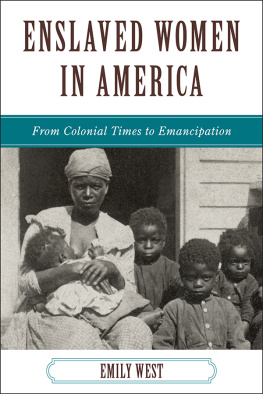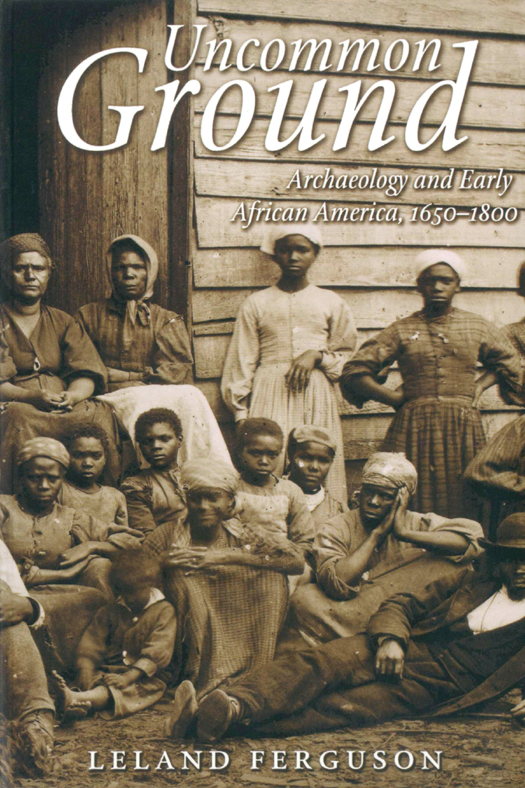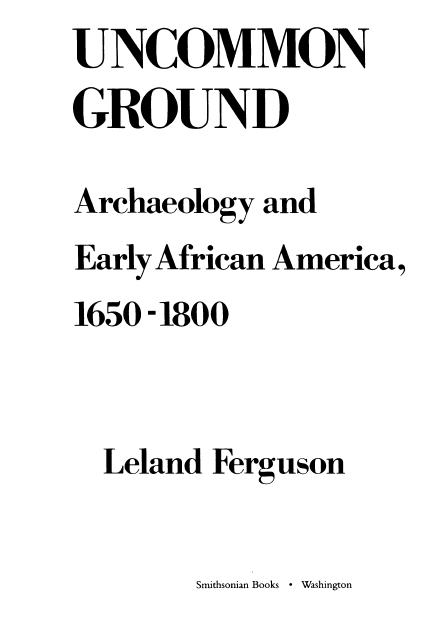Copyright 1992 by Smithsonian Institution
All rights reserved
Editor: Robin A. Gold
Production Editor: Eileen DAraujo
Designer: Janice Wheeler
Library of Congress Cataloging-in-Publication Data
Ferguson, Leland G.
Uncommon ground : archaeology and early African America, 16501800 / by Leland
Ferguson
p. cm.
Includes bibliographical references and index.
ISBN 13: 978-1-56098-059-9
1. SlaverySouth Carolina. 2. SlavesSouth CarolinaSocial conditions. 3. PlantationsSouth Carolina. 4. South CarolinaAntiquities. 5. South CarolinaHistoryColonial period, ca. 16001775. 6. Afro-AmericansSouth CarolinaAntiquities.
I. Title.
E445.S7F37 1992
975.700496073dc20 91.52833
CIP
British Cataloguing-in Publication Data available
This is an electronic release (eISBN: 978-1-58834-358-1) of the original cloth edition.
For permission to reproduce illustrations appearing in this book, please correspond directly with the author. Smithsonian Books does not retain reproduction rights for these illustrations. Permission to use the lines from the Prelude to Work Song and Blues by Edward Kamau Brathwaite from Rights of Passage, 1967, was generously given by the publisher, Oxford University Press.
www.smithsonianbooks.com
v3.1
For my students and others who aim to become archaeologists
Contents
Chapter 1
HANDMADE POTS
Chapter 2
NORTH AMERICAS SLAVE COAST
Chapter 3
CAROLINAS AFRICAN AMERICAN MAJORITY
Chapter 4
POWERFUL LEGACY
List of Figures
. Homes of freed slaves on an old plantation street, St. Helena Island, South Carolina, circa 19001910
. Middleburg Plantation house
. African American women threshing rice at Middleburg Plantation, circa 1900
. Dugout canoe discovered along the Edisto River in the South Carolina lowcountry
. Artifacts from the Middleburg Plantation slave quarters
. Middleburg Plantation map dating to 1786 showing Negro Houses, Berkeley County, South Carolina
. Fragment of a fire charred jar used by slaves for cooking in colonial South Carolina
. Floor plan from a Kingsley Plantation slave cabin excavated by Charles Fairbanks in 1969, the first excavation of its kind in the United States
. Shad Hall of Sapelo Island, Georgia, remembered his grandmothers clay pots and cups
. European-style cup found at Colonial Williamsburg, height: 9.5 cm
. English delftware bowl of about 1740 and a locally made example of similar shape
. English delftware porringer handle and locally made examples
. Colono Ware and European ceramics excavated at Drayton Hall Plantation on the Ashley River, South Carolina
. Colono Ware and European ceramics from plantation sites in South Carolina and Virginia
. Jug from the Combahee River at Bluff Plantation, Colleton County, South Carolina
. Sister Elizabeth Coakleys basket stand on U.S. 17 near Mt. Pleasant, South Carolina
. Adelaide Washington carrying a coiled basket to the field, St. Helena Island, circa 19001910
. Fragments of eighteenth-century coiled basketry from excavations at the Heyward-Washington House privy, Charleston, South Carolina
. Contemporary vessel handbuilt by descendants of slaves on the island of Nevis, West Indies
. Tripod legs and flat bases on these Catawba and Pamunkey vessels from the nineteenth century show accommodations to the hard, flat surfaces of European-style hearths and tables
. Charring on jar from the South Carolina lowcountry
. Marks on bowl bases found in the Cooper River, South Carolina
. Lid wear on the rim of a bowl from near Williamsburg, Virginia
. Drip lines from a sealing infusion on a pot from near Williamsburg, Virginia
. Cutlery marks in a bowl found in the Combahee River at Bluff Plantation, Colleton County, South Carolina
. White flakes of shell temper speckle the surface of a bowl found in Williamsburg, Virginia
. Bowl found in the Cooper River, South Carolina. A repair made before firing shows on the left side of the rim
. Colono Ware vessel with spall fracture and firing-cloud, found in the Cooper River at Mepkin Plantation, Berkeley County, South Carolina; height: 12 cm
. Creek and hills along the Colonial Parkway between Williamsburg and Jamestown, Virginia
. Ben Brown and two companions in a tidal creek on St. Helena Island, South Carolina, circa 19001910
. Demography and ethnicity on the South Atlantic Coast, 15261800
. Colono Ware variability along the South Atlantic Coast
. Fragments of San Marcos complicated-stamped cooking jars from St. Augustine, Florida
. First European American servants, then African American slaves labored with iron hoes in Virginia tobacco fields
. Tripod legs and flat bases on Colono Ware from seventeenth-century Virginia were made to be used on European-style hearths and tables
. Spalling on a Colono Ware pot from the Pettus site near Williamsburg, Virginia
. Poorly fired bowl base from the Pettus site near Williamsburg, Virginia
. Shackles, locks, and keys from excavations at the Kingsmill tract plantations symbolize the rigid controls of slavery in colonial Virginia
. Tobacco pipes decorated with West African-style designs from the Kingsmill tract near Williamsburg, Virginia
. Nineteenth-century Colono Ware plates with cutlery marks, excavated on the Pamunkey Indian Reservation, Virginia
. Plans of slave quarters found on the Kingsmill tract near Williamsburg, Virginia
. An African American wedding in the South Carolina lowcountry, late eighteenth century
. Excavated foundation of a clay-walled house at Curriboo Plantation, Berkeley County, South Carolina
. Foundation plan of a clay walled-house showing replacement posts, also shows adjacent structure; Curriboo Plantation, Berkeley County, South Carolina
. Archaeologists conception of middle eighteenth-century slave house at Curriboo Plantation, Berkeley County, South Carolina
. Nineteenth-century Jamaican house similar to houses excavated in colonial South Carolina
. Post structure from Yaughan Plantation, Berkeley County, South Carolina
. Palmetto thatching on an early twentieth-century outbuilding, St. Helena Island, South Carolina. In the foreground, Mrs. Rebeccah Green winnows rice using a coiled fanner basket
. Animal shed thatched with palmetto fronds, St. Helena Island, South Carolina, twentieth century
. Plank roof on a house with stick and clay chimney, St. Helena Island, South Carolina, 1909. In the foreground, Alfred Graham, an ex-slave and African, sews a coiled basket with his grandson at his knee
. Plan of house excavated at the Spiers Landing site, Berkeley County, South Carolina
. Archaeology students excavating an early African American house on Middleburg Plantation, East Branch Cooper River, South Carolina
. Room dimensions of African American houses, 17501800
. Earthen-walled houses in Nigeria typically have small rooms, rectangular plans, and clay walls similar to those found in colonial Carolina
. House built by Tahro, an African, in Edgefield County, South Carolina, 1907
. During a Revolutionary War battle, British soldiers defended themselves in houses with clay walls, probably the line of slave quarters shown on this copy of a 1791 map of Quinby Plantation, South Carolina






